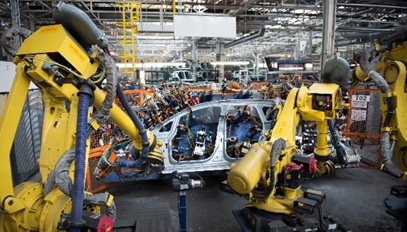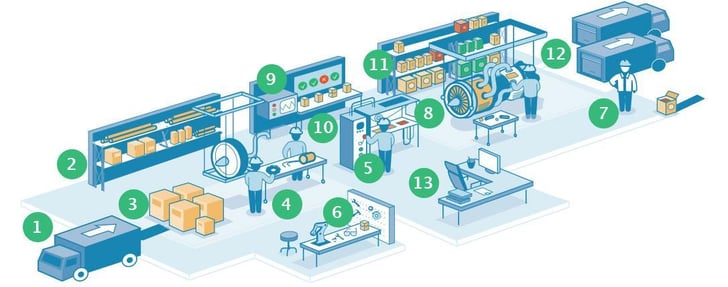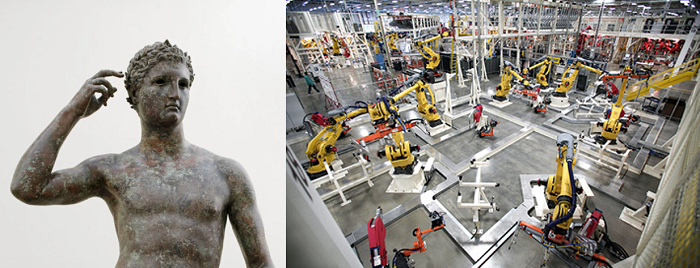The Internet of Things (IoT) is creating quite a buzz. In fact, one of our engineers wrote an introductory blog about IoT a few weeks ago titled, “Making Sense of IoT -- the Musings of an Engineer, Part I”. It’s worth your time to read if you’re unsure about what exactly IoT is. This blog is the first in a series – from my Sales POV – about IoT and how to talk about it within your manufacturing organization.
While my role here at Zero Wait-State is primarily a Sales Consultant, I’m also a civil engineer and thus have a unique perspective from both the business-side and the technical-side of IoT. And I’m starting to see a lot of confusion about IoT within the manufacturing industry. Kevin Ashton, cofounder and executive director of the Auto-ID Center at MIT, first mentioned the Internet of Things in a presentation he made to Procter & Gamble in 1999. He surmised “If we had computers that knew everything there was to know about things -- using data they gathered without any help from us -- we would be able to track and count everything and greatly reduce waste, loss and cost. We would know when things needed replacing, repairing or recalling and whether they were fresh or past their best.”
 The confusion stems from the fact that many manufacturing industries – both distributed and processing – have been connecting assets to gather information for decades. Supervisory Control And Data Acquisition (SCADA) and Distributed Control Systems (DCS) have provided industries from water treatment to refineries with the critical information they need to do everything from purifying water to refining petroleum. This is nothing new.
The confusion stems from the fact that many manufacturing industries – both distributed and processing – have been connecting assets to gather information for decades. Supervisory Control And Data Acquisition (SCADA) and Distributed Control Systems (DCS) have provided industries from water treatment to refineries with the critical information they need to do everything from purifying water to refining petroleum. This is nothing new.
But from the myriad of initiatives, it sounds like something new to manufacturing. Here are some examples:
- • GE’s Brilliant Factory
- • Industrial Internet Consortium
- • Industrial Internet of Things (IIoT)
- • Smart Manufacturing
- • Industry 4.0
One of the key differences between IoT and the current status quo of connected devices is the connection method. In the past, before the digital revolution and internet, industrial devices and sensors were analog and were hardwired to marshalling cabinets where the analog signals were converted to digital outputs. Each device had to be physically connected to the appropriate controller, which is costly and time consuming. With the advent of wireless sensors and the internet, it is now possible to connect industrial assets with much less effort and at a fraction of the cost than before to create a smart connected operation (SCO).
So, how do you talk to manufacturers about IoT?
 First, the phrase IoT may not resonate because they may believe that they are already “connected” and have control centers with dashboards to provide critical asset information on their plants. That said, manufacturers are continuously trying to improve operational performance – perform more efficiently, improve quality and increase production. And they want to leverage their existing infrastructure and equipment, whenever possible.
First, the phrase IoT may not resonate because they may believe that they are already “connected” and have control centers with dashboards to provide critical asset information on their plants. That said, manufacturers are continuously trying to improve operational performance – perform more efficiently, improve quality and increase production. And they want to leverage their existing infrastructure and equipment, whenever possible.
Traditionally, there has been a “wall” between Operational Technology (OT) and IT. For instance, many DCS vendors go out of their way to make sure IT is not involved in the OT decision process. In their defense, many IT organizations in the past lacked the process control expertise until the recent digitalization of the plant floor. This is no longer possible as it is critical IT understands and participates in the decisions regarding the type of data collected as well as the processing of data through analytics for better decision making throughout the enterprise. Furthermore, recent cyber-attacks on manufacturing facilities, like the Stuxnet malware, make IT’s participation imperative. Therefore, when having a discussion, it’s important to have all the right people involved. This would include, but not limited to:
- • Operations/Manufacturing
- • CIO/ IT
- • Finance
- • Quality
- • Reliability and Maintenance
- • Plant management and operations
Any opportunity where any of these business functions are not involved in the IoT discussion will be severely hampered.
Any discussion should focus on the promise of IoT – the ability to drive better decisions by providing the right connected data to the right role at the right time – and potentially without using the word “IoT”. In the past, access to certain manufacturing information was cost prohibitive and difficult to extract. This mindset is still prevalent within some manufacturing environments and they may be unaware of the available IoT technologies and platforms. Here are some IoT discussion icebreakers:
- • Are you able to access all the real-time connected data needed to make critical decisions to
improve operational performance? - • What data can’t you access?
- • Did you know it may be easier and less costly to access data from your current plant assets?
- • Is your company using analytics or machine learning to improve production?
- • Does your operations team have the information and tools it needs to discover areas for
improvement and to conduct root cause analysis? - • Are there any operational KPIs you wish you could measure?
- • Are various business functions able to collaborate electronically through your current systems of
record - ERP, PLM, etc? - • Is there an initiative to reduce or eliminate plant floor paperwork?
- • Are your legacy systems of record able to communicate to newer systems?
- • Is it difficult to enhance and extend current legacy systems?

Image courtesy of GE
The objective is to get the manufacturer to talk about their operational goals and initiatives to determine their interest in a smart connected operation (SCO). By using terms and nomenclature familiar to the manufacturing environment, you will not only demystify the concept of IoT, but also educate the prospective manufacturer of new opportunities to improve their operational excellence.
What questions have you asked/been asked that started a conversation about IoT?
In my next blog, I’ll discuss how IoT and the future of PLM go hand-in-hand. I look forward to your comments below.
 Author Ken Madsen has over 20 years experience in sales and business development. A collaborative problem solver, Ken has helped product development teams at companies like Apple and ABB resolve their most critical PLM challenges. Prior to joining Zero Wait-State, Ken sold CAD/CAM and PLM solutions from Unigraphics to customers like Apple Computer and OCLI. He earned his BS Civil Engineering from Rice University and MBA from Northwestern University.
Author Ken Madsen has over 20 years experience in sales and business development. A collaborative problem solver, Ken has helped product development teams at companies like Apple and ABB resolve their most critical PLM challenges. Prior to joining Zero Wait-State, Ken sold CAD/CAM and PLM solutions from Unigraphics to customers like Apple Computer and OCLI. He earned his BS Civil Engineering from Rice University and MBA from Northwestern University.



